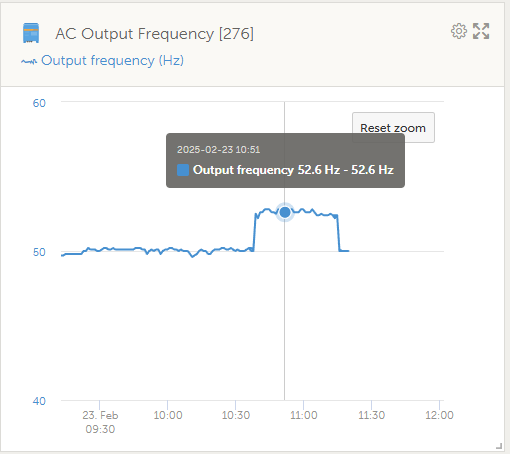I made a small addition to the title to reflect the above.
@plonkster it looks like the problem lies in Venus OS. I did a firmware update on a Multiplus II at another site. This time I switched off the AC input to the Multiplus II, and I also set the charge voltage limit in DVCC to 50V. This site has a SmartSolar 150/85 connected to 3.4kWp worth of panels.
This is what happened for a few seconds around the time of the firmware update:

As you can see the 50V charge voltage limit was ignored and the solar charger ran at full tilt for a short while.
Have the correct charge settings been set in the MPPT?
I do this with all my MPPT’s even if the GX has the control. That way if the GX stops doing its job they MPPT’s won’t overshoot.
Yes, I always set the Multiplus II and any MPPTs to a charge voltage of 52V before I bring any batteries near it. I wonder why that is not the default from the factory?
Next time before I do a remote firmware update on a Multiplus II I will set both the MPPT and DVCC charge voltage limits to 48V to see what happens.
The BMS bit is set in the network mode, which means when it stops getting external voltage setpoints it drops its charge voltage to 48V, and raises error #67.
It is still a good idea to set good settings on the MPPT, just in case it does somehow come up in standalone mode (that could happen if you lost BMS comms and some helpful tech resets the BMS bit on the charge controllers after restarting the Multi), but in this context it should not happen.
Sorry, I still need to look into this again. As I said… found the wrong bug and it got fixed. Now I have to go back to the dev and tell him it’s still an issue… well, first I have to check whether it is or isn’t.
Please let me know if there is anything I can do to assist. Both sites are on VRM, so if you think there will be anything useful in the logs I can send you the VRM IDs and the exact timestamps to look at.
I switched off the MP2 for a short while tonight, and this is what happened after I switched it back on:

Notice the 56V effective charge voltage for about a minute.
Perhaps the firmware update is a red herring, and there is something going wrong with the charge voltage immediately after the MP2 is switched on. All my devices are set to a 52V charge voltage, so I do not know where this 56V is coming from.
It happened again:
I switched the Multiplus II off in order to work on the battery bank. I then reconnected the battery bank after which I switched the MP2 back on.
I checked the settings on the MP2 as well as the SmartSolar - both are set to charge up to 52V. Everything is on the latest firmware. I do not know where it is getting this 56V from. I had the AC input as well the solar panels disconnected so it could not charge, but this is scary.
@plonkster Should I report it as a bug?
I think I know what it might be. Let me explain. This might be nothing to worry about.
The Multi has two “engines”. There is the BOL one, from the original internal naming “Battery Operational Limits”, when a managed battery steers things, and then there is what one might call the older legacy engine, which is the default engine it starts up with. These engines behave slightly differently.
The older engine uses an offset, which we call the Bulk offset, of 4V. That means that while it is in the bulk phase, it aims 4V higher than the programmed charge voltage (which, as you mentioned, is 52V). But this is only during the bulk phase.
As soon as it reaches the absorption voltage (plus 50mV), it will drop the bulk offset. In other words, it won’t actually charge to 56V. The bulk offset is there only to overpower any voltage drops on cables and make sure you get there.
This management of the bulk offset happens inside the Multi. It is not on the GX. It is nice and fast.
Once the BMS is detected by the GX device and the information is communicated to the Multi, the Multi switches to the BOL engine. The Bulk offset is then completely removed, so you will never see this during normal operation, just shortly after switching on.
Isn’t this +4V offset dangerous to an already fully charged battery? It might be for only a few seconds, but the 8kW+ MP2 has a beefy charger and can easily take an already fully charged Pylontech battery bank to 56V in the blink of an eye. I suspect this is what happened to the battery bank that prompted this thread.
Would a solution be to set the charge voltage on the MP2 to 48V instead of 52V?
I don’t think so. The moment the voltage reaches 52.05V, the Multi will remove the bulk offset. It happens in a split second.
As it turns out that plan is not viable due to an unwanted side-effect: I have a PV inverter on the output of the MP2, and when loadshedding hit this morning the PV inverter was throttled to almost 0 even though the battery was at 60%:
Changing the charge voltage in the MP2 back to 52V fixed the issue.

